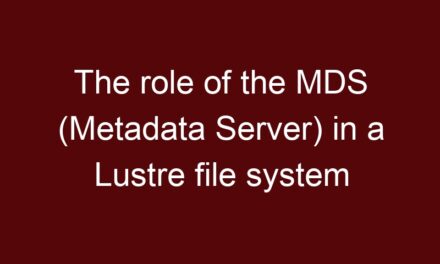Configuring and tuning Lustre for optimal performance involves a combination of hardware selection, file system settings, and network considerations. Here are some best practices to help you achieve high performance with Lustre:
- Choose High-Performance Storage: Select fast and reliable storage devices such as SSDs or high-performance HDDs for OSTs. Consider using RAID or replication for data redundancy and availability.
- Optimize Striping: Configure striping parameters based on your workload and storage setup. Align the stripe size with your application I/O patterns and the RAID stripe size, if applicable.
- Use High-Speed Interconnects: Utilize high-speed interconnects like InfiniBand or Ethernet with RDMA capabilities to reduce network latency and overhead. A low-latency network helps improve data transfer rates.
- Distributed Metadata: Use multiple MDSs to distribute the metadata load and ensure metadata scalability. Consider adding more MDSs as the file system grows.
- Metadata Caching: Enable metadata caching on client nodes to reduce the frequency of metadata requests sent to the MDS. Caching metadata locally helps reduce MDS load and improves metadata performance.
- Network Tuning: Tune network settings, such as MTU and buffer sizes, to optimize network performance for Lustre traffic.
- Monitoring and Profiling: Implement monitoring and profiling tools to identify performance bottlenecks and resource usage. Tools like Lustre stats, Lustre health monitoring, and Lustre performance analysis can provide valuable insights.
- Parallel I/O: Optimize your applications to take advantage of Lustre’s parallel I/O capabilities. Use multiple threads or processes to perform concurrent I/O operations.
- Use Lustre Tunable Parameters: Understand the impact of Lustre tunable parameters and adjust them based on your specific environment and workload characteristics. Fine-tuning these parameters can significantly impact performance.
- File Striping Policies: Define file striping policies based on your application’s I/O patterns and data access patterns. Use large stripes for large files and smaller stripes for small files to optimize performance.
- Defragmentation: Periodically defragment the Lustre file system to improve performance and maintain data layout efficiency.
- Avoid Metadata-Intensive Operations: Minimize the use of metadata-intensive operations that can put stress on the MDS, such as creating or deleting large numbers of small files.
- Benchmark and Test: Perform benchmarking and load testing with realistic workloads to identify performance limitations and adjust configurations accordingly.
- Documentation and Community: Refer to Lustre documentation and seek advice from the Lustre community to learn from best practices and experiences of other Lustre users.
Remember that Lustre performance tuning is often specific to the unique characteristics of your environment, workload, and storage infrastructure. Regular monitoring, profiling, and tuning are essential to maintaining optimal performance as your Lustre deployment evolves over time.





